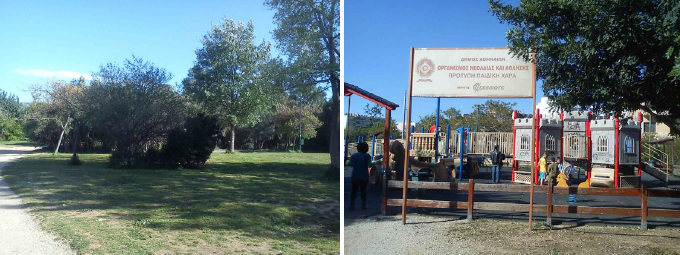Plato’s Academy
August, 2013
Contributor: City of Athens
Greening Plato’s Academy and creating a communal garden with local vegetable, herb and tree varieties.
Plato’s Academy is a city landmark since ever, as its name implies. It is the place where Plato taught and his philosophy was expanded and elaborated upon by Platonists. Despite its historical significance the area is seriously degraded. In modern Athens Plato’s Academy area has become a semi-industrial freight center. The park is not being used at its potential, being simply a green area with remains from ancient times and newly built infrastructure such as a small amphitheatre and a kids playing fun-park. The surrounding area is semi-residential and semi-industrial and the overall condition is by no means fair to the history and name of the place.
Our aim is to start ameliorating the area in total using Plato’s Academy Park as the center and starting point. In that sense the creation of small herbal and tree gardens is a first step to improve the overall condition and get local inhabitants to participate in the amelioration of the area. At the same time plants can function as e medium that connects locals and visitors to the history of the place, through the use of local plant varieties in Attiki, such as thyme, hypericum, olive trees, fig trees and so on. Through the plants the journey into the history of the place shall be more immediate and imaginative. Furthermore this newly created environment may have second hand effects into local businesses, since it will support Plato’s Academy cultural and educational significance, turning the area into an appealing destination for tourists.
We plan to start with recreating parts of the area within the Park and surrounding areas. (see attached pictures).
What are the context/initial motivations?
As explained above the initial motivation derives from the importance of the area related to the fact that it is seriously degraded. This motivates us for introducing new ways that will improve inhabitants’ quality of life. The use of land for cultivation purposes forms a vehicle for the upgrading of the area and the involvement of local population into the action.
What is the result (describe the solution/project/practice…)?
The expected result is a step by step recreation of the area in a way that links material and spiritual life. As you can see in the attached pictures we plan to start with two streets (Tripoleos st. and Ifigeneias st.) adjacent to the park. We believe that such an action can be much more effective for locals’ engagement, instead of focusing simply in the park area.
We should note that the “agricultural” land in Plato’s Academy shall serve mostly educational and cultural purposes. Environmentally speaking the soil and the atmosphere in this area is seriously degraded to support food production at once. However techniques for low CO2 emissions can be introduced such as sowing small plots with seeds. As a a result people will get to know how to improve and revive soil without using heavy machinery and synthetic fertilizers.
Eventually people will get to learn about agricultural production, and be able to maintain small vegetable or herb gardens in the Park.
What are the benefits (environmental/social/economical…)
An expected benefit is the amelioration of inhabitants’ quality of life, their connection to “agricultural production” and an understanding of its importance.
Furthermore the area’a image will be greatly improved, making it more attractive to local and foreigner tourists.
As a consequence this shall help local businesses and potentially lead to new jobs.
We do not expect though that Plato’s Academy will become an farming area for food production.
Discuss Pro and Contra
Pro:
- The area is well known due to the name it bears.
- There exists enough land beyond the park to extend the activities.
- Locals are active in implementing related projects at a very small scale.
Contra:
- The area is seriously degraded.
- The plots of derelict land are not well identified and it shall take quite a time to check owners’ status and land use.
We believe that the most important lesson to be learned is how to recreate a degraded historical area, link this recreation to sustainable food production and involve locals into action.
Question to the network:
Is there any other city that has faced the challenge of recreating an area of historical significance through the use of sustainable food systems, and agricultural production in particular?
